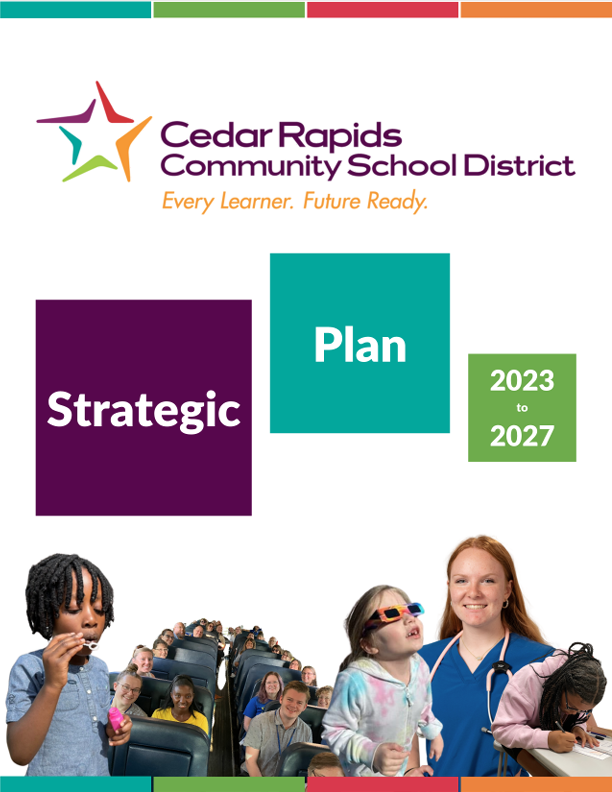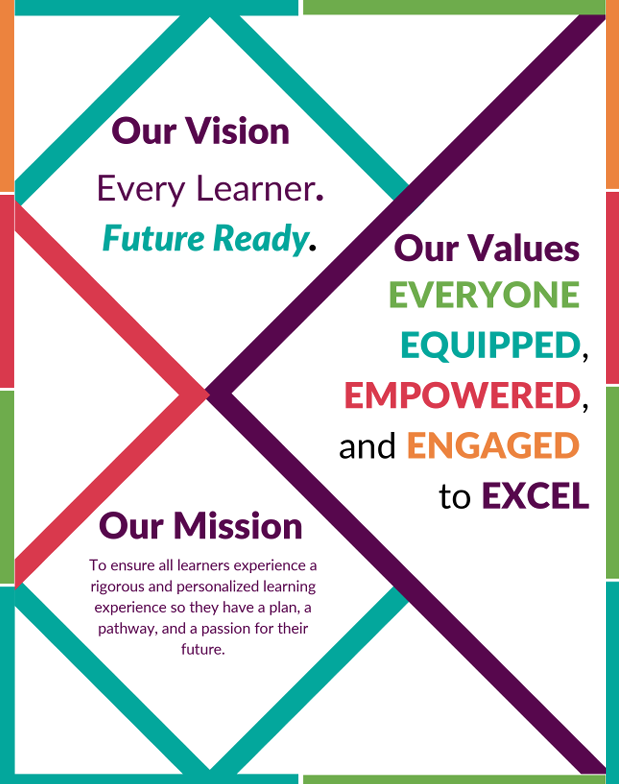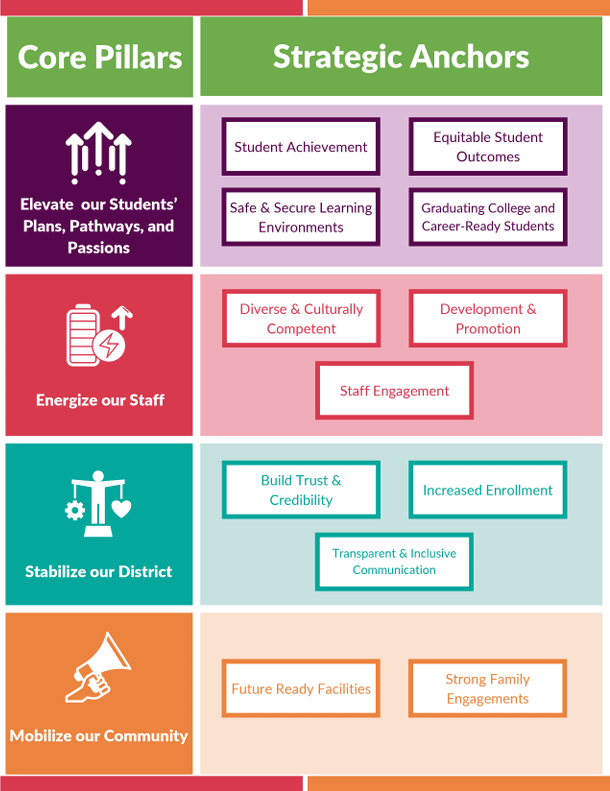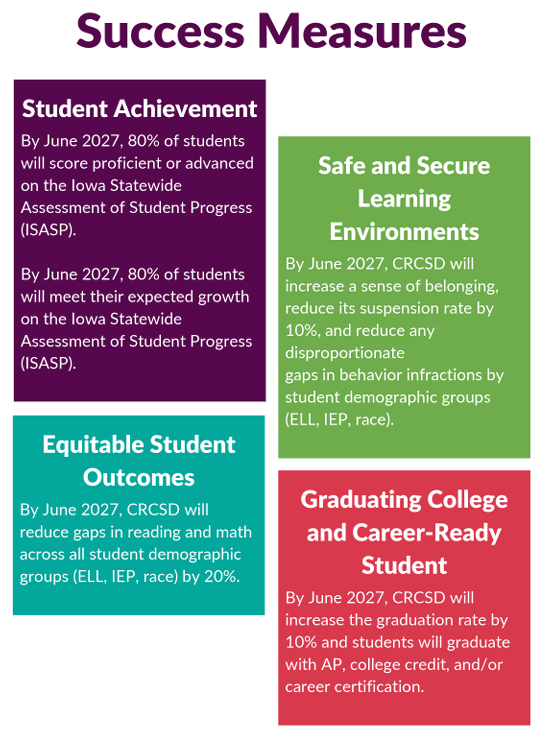The Cedar Rapids Community School District has embarked on a comprehensive strategic planning process, meticulously designed to cater to the diverse needs and expectations of the community. This strategic plan is created through a multi-phase approach, involving extensive needs assessment, consultative facilitation and analysis, development and feedback from various stakeholder groups, board approval, and meticulous implementation. The intent of this strategic plan is to foster an environment of continuous improvement, ensuring that every decision made aligns with the collective vision and goals of the District and the broader Cedar Rapids community.




Strategic Planning Process
Cedar Rapids Community School District engages in a strategic planning process every three to five years, per Board policy 0101 and regulation 0101.R(1). The process consists of five phases:
1) Comprehensive Needs Assessment: a multifaceted and cross-sectional assessment of the District consisting of listening sessions, surveys, stakeholder interviews, and data analysis.
The Comprehensive Needs Assessment is a thorough and intricate evaluation of the District’s requirements. It involves a multifaceted approach that includes listening sessions, surveys, stakeholder interviews, and data analysis. This cross-sectional assessment aims to comprehensively understand the District’s needs from various perspectives and sources. The listening sessions allow individuals to express their opinions and concerns, while surveys offer a statistically significant sample of the population’s views. Stakeholder interviews allow for in-depth conversations with key individuals with a vested interest in the District. Finally, data analysis provides a quantitative assessment of the District’s needs. This approach offers a holistic view of the District’s needs, ensuring that all pertinent information is considered in the decision-making process.
2) Consultative Facilitation and Analysis: an analysis for needs assessment completed by an outside entity to ensure an unbiased evaluation of the District’s most pressing needs.
Consultative facilitation and analysis is a process of conducting a thorough evaluation of the needs of a district by an external entity. This evaluation aims to ensure an objective and unbiased analysis, which can help identify the district’s most pressing needs. The analysis involves collecting pertinent information, such as surveys, interviews, focus groups, and data analysis. The data collected is carefully analyzed by experts who provide recommendations and solutions to address the identified needs. This process helps the district make informed decisions and develop effective strategies to improve its operations and services.
3) Development and Feedback: a multi-step, inclusive process conducted by the superintendent of schools to develop and seek feedback from multiple stakeholder groups including, but not limited to, the Board of Directors, Executive Cabinet, District committees, work groups, etc.
Development and Feedback is a multi-step and inclusive process that the superintendent of schools conducts. This process involves developing and seeking feedback from multiple stakeholder groups, including but not limited to the Board of Directors, Executive Cabinet, District committees, work groups, and other pertinent parties. This comprehensive approach ensures that all relevant parties have a say in the decision-making process and that the resulting outcomes accurately reflect the needs and perspectives of the entire community. Through this process, the superintendent can make informed decisions that positively impact the school district and its stakeholders.
4) Approval: a strategic plan overview is presented to the Board of Directors, seeking approval of the core pillars, strategic anchors, progress, and success measures.
At a Board of Directors meeting, a comprehensive strategic plan overview will be presented for approval. The outline will cover the plan’s core pillars, including the key focus areas for the organization’s future success. Additionally, the presentation will highlight the strategic anchors, which represent the foundational principles that guide decision-making and actions. The progress measures will be shared to provide insight into how the plan is implemented and whether it achieves its intended outcomes. Lastly, the success measures will be presented, outlining the goals and targets the organization aims to achieve by implementing the strategic plan.
5) Implementation: a multi-year process that empowers the Superintendent and District to be fluid and responsive, with a vision and implementation plan to meet approved outcomes.
Implementation is a complex and long-term process involving a series of actions and strategies to enable the Superintendent and the District to be flexible, adaptable, and responsive to the changing needs and expectations of the stakeholders. It requires a clear vision and a well-defined implementation plan that outlines the specific outcomes, objectives, and milestones to be achieved over a multi-year period. The implementation plan should also include a set of metrics and performance indicators that enable the District to track progress, identify challenges, and make necessary adjustments to ensure that the desired outcomes are achieved. Additionally, effective implementation requires strong leadership, effective communication, and collaboration among all stakeholders, including teachers, staff, parents, community members, and local partners.
The multi-step process in place is designed to provide the Board of Education with the authority to govern the District effectively while enabling the Superintendent to manage the day-to-day operations of the educational institution. This approach creates a conducive environment for all stakeholders to work together seamlessly towards achieving the District’s goals and objectives. Through this process, the Board of Education can exercise its oversight responsibilities while the Superintendent can focus on efficiently delivering instructional programs and services to students.